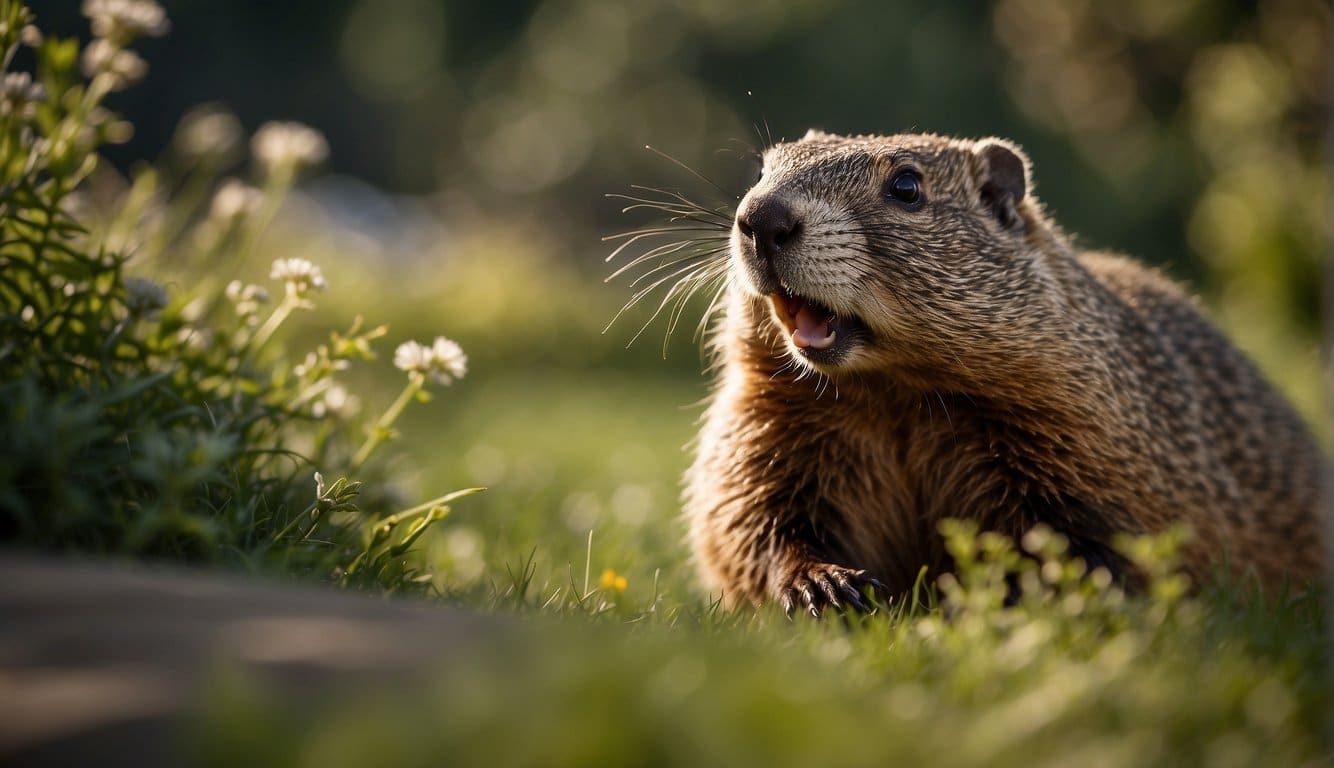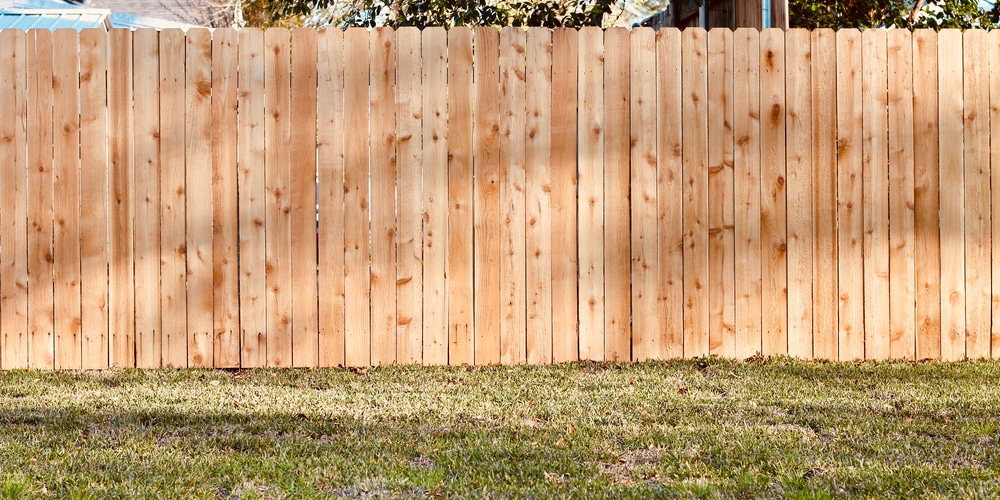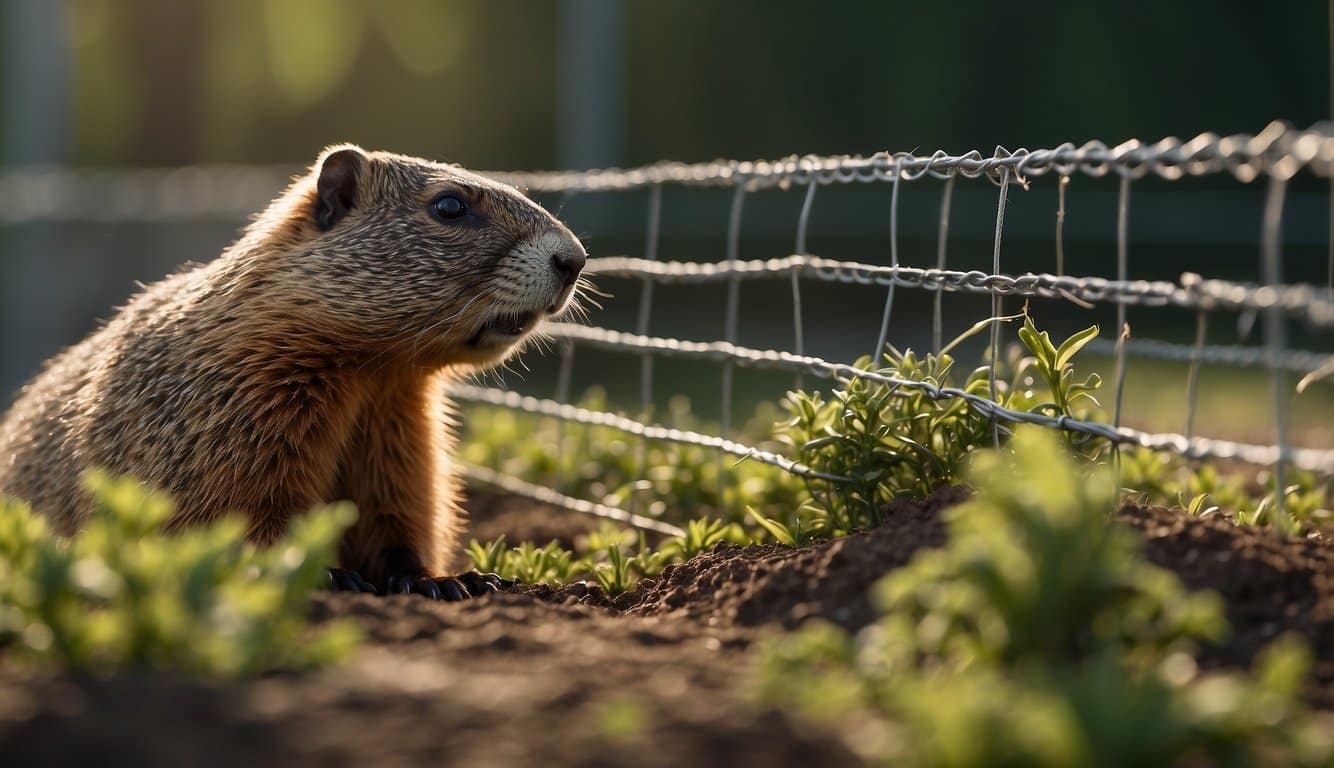The Groundhog Gauntlet: Effective Humane Traps
Before you rally the troops for a backyard groundhog battle, know your strategy.
Arm yourself with the most humane and effective traps – because it’s not just about winning, it’s about coexisting victoriously.
Choosing Your Trap
- Box Trap: The tried and true method for capturing groundhogs humanely.
- Make sure it’s large enough – at least 30 inches long.
- Cage Trap: Sturdy wire construction is key.
- Look for one with a trigger-sensitive mechanism to ensure success without harming the critter.
Baiting Strategies
- Fruits and Vegetables: Groundhogs can’t resist fresh cantaloupe, sweet corn, or string beans.
- Greens:
- Romaine lettuce
- Peas
- Leafy greens
Proper Placement
- Near Burrows: Place traps along the paths or near the entrance of a groundhog’s burrow.
- Flat Surface: Keep it stable to avoid scaring off your burly intruder.
Safe Release Procedures
- Protect Yourself: Wear thick gloves to avoid a surprisingly sharp rebuttal from your captive.
- Transportation: Cover the trap with a dark cloth to calm the groundhog during relocation.
- Release Area: Choose a location at least 5 miles away – ensure it’s groundhog-friendly with access to water and cover.
Repellents and Deterrents: Keeping Groundhogs at Bay
When it comes to pesky groundhogs, your garden doesn’t have to become their favorite buffet.
Here, we’re zeroing in on effective ways to say “Not in my backyard!” with natural repellents, commercial solutions, and physical barriers that stand guard against these furry intruders.
Natural Repellents
- Epsom Salt: Sprinkle Epsom salt around your garden beds.
- Groundhogs find the taste unpleasant, deterring their munching habits.
- Essential Oils: Create a mixture of essential oils like clove and lavender.
- Groundhogs are not fans of these scents. Learn more on essential oil repellents.
Commercial Solutions
- Ultrasonic Devices: Install devices that emit a sound frequency groundhogs dislike, ushering them away from your green space.
- Ammonia Soaked Rags: Soak rags in ammonia and place them near burrow entrances.
- The strong smell convinces groundhogs to relocate.
Physical Barriers
- Fencing: Erect a fence at least 12 inches underground and a few feet above to prevent digging and climbing.
- Mesh Wire: Cover your plants with mesh wire, making it difficult for groundhogs to reach their next meal.
Garden Guard: Protect Your Green Haven
Your garden is your sanctuary, but pesky groundhogs can turn it upside down.
Protect your greenery with these targeted strategies to keep those unwelcome guests at bay.
Plants That Groundhogs Dislike
- Epsom Salt: Spread Epsom salt around your garden’s perimeter to dissuade groundhogs with its bitter taste.
- Cayenne Pepper: They can’t stand the strong scent of cayenne pepper, so sprinkle it generously.
- Lavender and Thyme: Incorporate these plants, as their fragrances are natural groundhog repellents.
For a detailed approach on utilising Epsom salt and essential oils, check out The Spruce and Farmers’ Almanac.
Fencing Techniques
- Height Matters: Ensure your fence stands at least 3 feet tall to prevent groundhogs from jumping over.
- Below the Surface: Extend the fencing about a foot deep to stop diggers in their tracks.
Refer to MorningChores for more on effective fencing strategies.
Electronic Devices
- Motion-Activated Sprinklers: Install to startle and shoo away groundhogs with a burst of water.
- Ultrasonic Repellents: These emit sounds that are irritating to groundhogs but inaudible to humans.
To explore the use of electronic devices in more depth, the advice at Bob Vila’s guide can be very helpful.
Habitat Modification: Making Your Property Unattractive
To keep those burrowing visitors at bay, tweak your property to be the least appealing groundhog getaway spot.
It’s all about removing the buffet and hiding places they love so much.
Removing Food Sources
- Seal Your Trash: Ensure trash bins have tight-fitting lids; groundhogs can’t resist an easy meal.
- Tidy Up the Greens: Regularly harvest fruits and vegetables; groundhogs are less inclined to dine in a garden that doesn’t offer a feast.
- Limit Bird Feeder Spill: Install catch trays under bird feeders to prevent seed spillage, or better yet, remove them during peak groundhog activity seasons.
Eliminating Hiding Spots
- Trim and Tidy: Keep the grass mowed and shrubbery pruned back to reduce shelter options.
- Dismantle Debris: Piles of wood, rocks, or yard waste can be prime real estate for a groundhog; best to clear those out.
- Secure Sheds and Structures: Use fencing material like chicken wire around the base of sheds and decks to prevent groundhogs from setting up home underneath.
Professional Assistance: When to Call the Experts
Sometimes, your furry little invaders may be more than you can handle. That’s when calling in the pros can save your garden and your sanity.
Identifying a Groundhog Problem
- Visual Confirmation: Spotting a groundhog is a sure sign. Look for a medium-sized, furry animal with a bushy tail.
- Burrow Entrances: Groundhogs dig distinctive burrows with openings of about 10-12 inches across, often with mounds of dirt at the entrance.
- Plant Damage: If your vegetables are vanishing and large, leafy plants are nibbled down to nubs, it’s likely a groundhog’s handiwork.
- Noise and Tracks: Unusual noises or tracks in your yard could point to a groundhog guest.
Benefits of Professional Removal
- Humane Methods: Professionals are trained to remove groundhogs humanely, ensuring the creatures aren’t harmed.
- Effectiveness: Experts have the skills to ensure groundhogs are caught and remove them effectively from your property.
- Prevention Tips: After removal, professionals can offer advice to help you keep groundhogs away, saving you future headaches.
- Legal Compliance: They know the local wildlife laws and ensure that the removal complies with them, which is crucial for a worry-free process.
Frequently Asked Questions
Dealing with groundhogs in your yard can be tricky, but armed with the right methods, you can handle the situation with humane and effective strategies.
What humane methods can be applied to encourage groundhogs to vacate an area?
- To humanely encourage groundhogs to leave, you can use castor oil as a repellant, drenching their burrow entrances to create an unsuitable living environment.
- Live traps baited with fruits or vegetables can capture groundhogs, which you can then relocate to a wooded area far from your property.
Can certain smells or natural repellents effectively deter groundhogs from gardens?
Groundhogs have a sensitive sense of smell, and you can take advantage of this by using natural repellents like ammonia or even human hair to send them on their way.
What quick-action strategies are effective for groundhog removal?
In a pinch, techniques like flooding their burrows with water can prompt groundhogs to find a new home, although this is more of a temporary fix and further steps should be taken to ensure they don’t return.
Are there any DIY repellent recipes that will prevent groundhogs from settling in?
Yes, mixing essential oils like lemongrass or lavender with water in a spray bottle and misting around the garden perimeter can be a pleasant-smelling deterrent for those persistent groundhogs.
What tactics can homeowners use to prevent groundhogs from burrowing in the yard?
- Burrowing fences installed deep into the soil can prevent groundhogs from tunneling into your space.
- Regularly inspecting for and sealing up any potential burrow sites can go a long way to keeping them out.
Which plants or garden layouts might naturally repel groundhogs?
Groundhogs tend to avoid some plants like daffodils and lavender.
Incorporating these into your garden design can be a lovely and natural preventative measure against these critters.
Last update on 2025-04-26 / Affiliate links / Images from Amazon Product Advertising API




